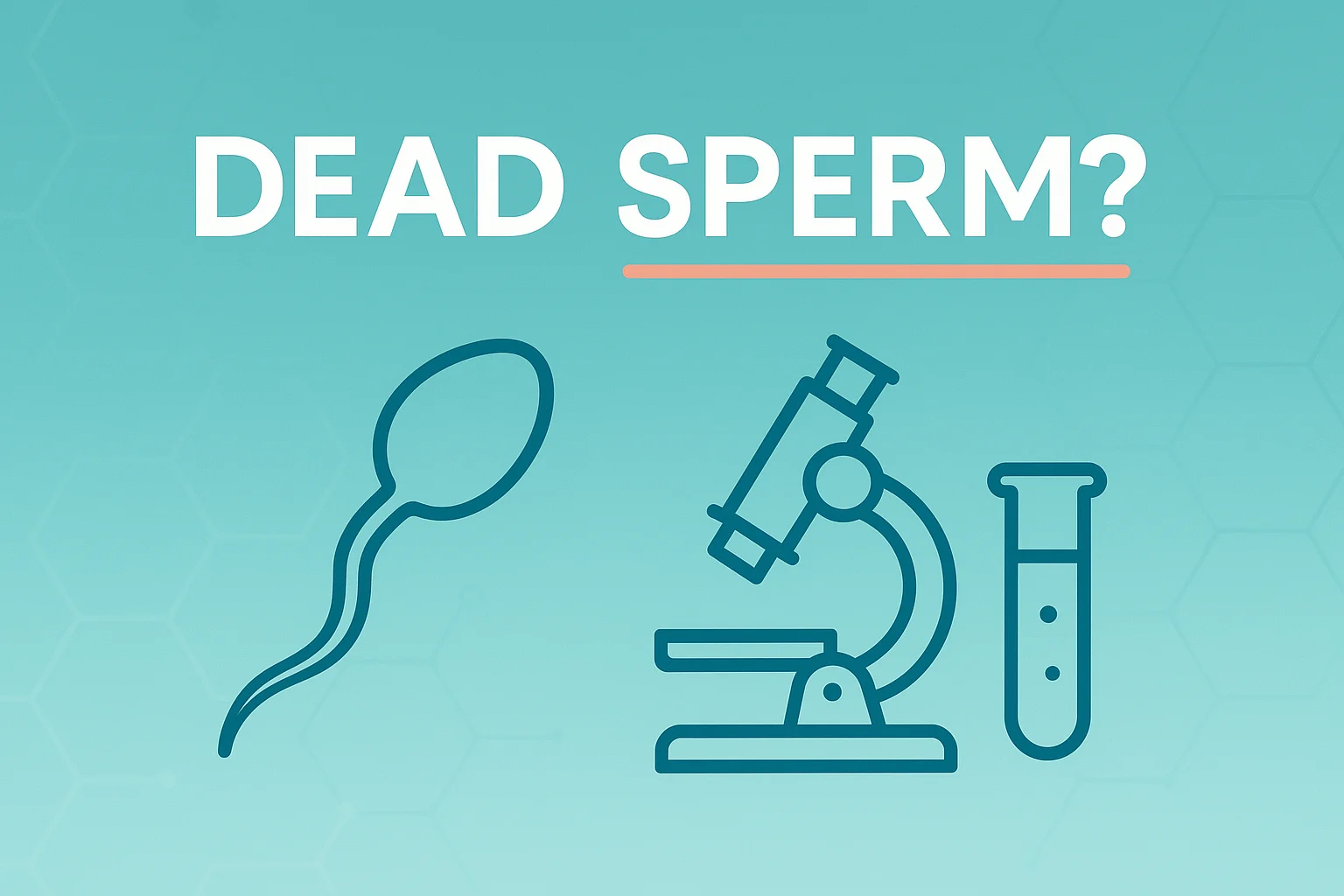Hearing that a semen report shows “dead sperm” can be alarming. You’re not alone, and it’s not the end of the road for fertility. In medical language, “dead sperm” points to poor sperm vitality—a higher-than-usual proportion of non-viable sperm cells (not alive). This can have many causes, most of them manageable, and modern fertility labs have precise ways to test vitality and work around it when you’re trying to conceive.
This guide explains, in plain English, what “dead sperm” means, how labs test it, common reasons it shows up on reports, and the practical options—from lifestyle fixes to advanced IVF/ICSI—that couples use to move forward.
What people mean by “dead sperm” (and the medical term)
Clinically, doctors talk about sperm vitality (the percentage of live sperm in a semen sample). Historically, when fewer than 58% of sperm were alive, the pattern was labelled necrozoospermia/necrospermia. The latest WHO 6th edition of the semen analysis manual moved away from rigid labels and instead advises adding a vitality test whenever total motility is <40%—because poor movement could be due to either dead sperm or live-but-immotile sperm, and the distinction matters. PMC+1World Health Organization
Key idea: Not all motionless sperm are dead. Some are viable but immotile (for example, after certain infections or flagellar defects). That’s why a vitality test sits beside the motility reading on a high-quality report. PMC
How labs check if sperm are dead or alive
The basics of a good semen analysis
A standard semen analysis measures volume, concentration, motility, morphology—and adds vitality when movement is low. For accuracy, sample collection follows WHO guidance:
- Abstinence: typically 2–7 days before collection.
- Clean, wide-mouth sterile container, no lubricants or regular condoms (they may contain spermicides).
- Timing & temperature: deliver within 30–60 minutes and keep near room temperature/body temperature during transport.
These small details can prevent false “low vitality” due to sample mishandling. PMC
Vitality tests your report may mention
- Eosin–Nigrosin (dye-exclusion) stain
Live sperm exclude the dye; dead sperm absorb it. This quick, validated test estimates the percentage alive vs. dead in minutes. PMC - Hypo-Osmotic Swelling (HOS) test
Sperm with intact membranes swell/coils in a specially prepared solution; dead sperm don’t. HOS is also used clinically to pick viable but non-motile sperm for ICSI. Cambridge University Press & Assessment - When is vitality added?
Per WHO 6th edition, labs add vitality when total motility is <40%—so your report can tell poor movement due to death versus other reasons. PMC
Dead sperm vs. live-but-immotile: a quick view
| Feature | Dead sperm (non-viable) | Live but immotile |
|---|---|---|
| Membrane integrity | Lost; takes up dye on Eosin–Nigrosin | Intact; excludes dye |
| HOS test | No swelling | Swelling/coil tail |
| Usable for ICSI | Not usable | Often usable (selected under microscope) |
| Typical next steps | Find cause; consider surgical sperm retrieval if persistent | Use viability selection (HOS/laser/motility stimulants) for ICSI |
(Selection techniques discussed below.) Cambridge University Press & AssessmentPMC
Why do many sperm show up “dead” in the sample?
It’s usually multi-factorial, and sometimes temporary. Research suggests necrozoospermia is uncommon (about 0.2%–0.4% of infertile men), but lesser degrees of low vitality are seen more often. PMC
Common contributors include:
- Genital tract infections/inflammation (prostatitis, epididymitis): toxins and reactive oxygen species (ROS) can kill sperm or damage membranes. PMC
- Fever/systemic illness in the prior 2–3 months: sperm take ~74 days to develop; a recent high fever can transiently depress vitality. AUA Net
- Varicocele (dilated scrotal veins): raises testicular temperature and oxidative stress. AUA Net
- Heat exposure (hot tubs, laptops on lap, tight synthetic underwear), toxins (pesticides/solvents), smoking, heavy alcohol, poorly controlled diabetes, obesity—all linked to oxidative stress and cell death. MDPI
- Prolonged abstinence/epididymal stasis: longer storage can increase ROS and cell death; shorter intervals sometimes improve motility/vitality. PMC
- Antisperm antibodies (occasionally, for example after vasectomy reversal) may coexist with necrozoospermia. ScienceDirect
- Pre-analytical issues: partial loss of sample (missing the first fraction), delay to lab, extreme temperatures, or use of spermicidal condoms/lubes can artefactually lower vitality. PMC
What you can do next
First: get a high-quality, repeat semen analysis with vitality
Semen parameters fluctuate. Doctors usually repeat the test after at least 2–3 weeks under best-practice collection conditions, and add a vitality test if motility is low. If confirmed abnormal, a fertility specialist may check hormones, infections, varicocele, lifestyle risks and medications. The AUA/ASRM Male Infertility Guideline outlines a systematic, evidence-based approach. AUA Net+1
At-home prep for the next test (simple but important):
- Abstain for 2–7 days (your clinician may advise the shorter end if vitality is low).
- Avoid spermicidal condoms/lubricants; collect the entire sample.
- Deliver within 30–60 minutes; keep close to body temperature (no fridge).
- If ejaculation is difficult in clinic, ask about special collection condoms suitable for lab analysis. PMC
Tip some clinics use: a second ejaculation a few hours after the first can yield sperm with lower DNA fragmentation and better motility, which may help during IVF/ICSI planning. This is clinic-directed; don’t DIY without guidance. SpringerOpen
Lifestyle changes that support sperm health
- Stop smoking; limit alcohol; aim for a healthy BMI, good sleep, regular exercise.
- Heat hygiene: avoid hot tubs/saunas; don’t park laptops on the lap; prefer breathable underwear.
- Antioxidants (diet first; supplements only with clinician advice): Evidence from Cochrane suggests low-certainty improvements in clinical pregnancy/live birth; data are mixed and dosing is individual—discuss with your doctor. CochranePubMed
Medical treatments depend on the cause
- Treat infections (antibiotics/anti-inflammatories if prescribed).
- Varicocele: your urologist may discuss repair if indicated.
- Endocrine/metabolic issues: optimise diabetes/thyroid/testosterone as medically appropriate.
- Counselling on exposures (toxins, medications) and timing of repeat testing.
Your clinician will personalise this plan following guideline-based evaluation. AUA Net
Fertility options when many sperm are dead
When vitality is poor, strategies shift to finding and using the viable sperm you do have—or retrieving them upstream where they’re healthier.
Is IUI useful here?
Intrauterine insemination (IUI) relies on enough motile, viable sperm after processing. If vitality is significantly low, IUI success is typically limited; clinics usually consider IVF with ICSI instead.
ICSI with carefully selected viable sperm
In ICSI, the embryologist chooses a single sperm and injects it into the egg. With low vitality, labs can still find viable (even if immotile) sperm using:
- HOS-positive selection: choose sperm that swell in HOS—proof of life.
- Laser tail-flick test: a safe micro-laser pulse makes a live tail twitch/curl; dead tails don’t respond.
- Motility stimulants (pentoxifylline/theophylline) used in-lab on tiny drops (not as patient medication) to transiently wake movement for selection; usage is centre-specific and carefully controlled.
These methods help identify living sperm for ICSI without relying on motility alone; studies show no adverse neonatal outcomes with laser selection and report practical utility of stimulants in absolute immotility, though protocols vary. PMCBioMed CentralMedCrave Online
Using testicular sperm (TESE/TESA) when ejaculate sperm are mostly dead
Sometimes vitality is poor mainly after sperm leave the testis (for example, oxidative stress in the epididymis/ejaculate). In such cases, retrieving sperm directly from the testis can yield healthier DNA and better ICSI outcomes in selected scenarios (e.g., refractory necrozoospermia, very high DNA fragmentation, cryptozoospermia). Meta-analyses report lower DNA fragmentation and, in some groups, improved embryo and pregnancy rates with testicular sperm for ICSI—but this is not universal and must be weighed against a minor surgical procedure. Discuss centre-specific data and your case details with your clinician. PMCFertstertNatureScienceDirectPubMed
Short-interval “second ejaculate” strategy during IVF
Some clinics ask for a second ejaculate on egg-collection day, which may show better motility and lower DNA fragmentation, giving embryologists more viable choices. This approach is individualised. SpringerOpen
Donor sperm (if needed)
If repeated testing shows persistently no viable sperm and other options are unsuitable, donor sperm remains a compassionate, family-building pathway. Counselling and informed consent are essential.
Does diet or supplementation “revive” dead sperm?
No supplement can revive already dead sperm cells. The goal is to reduce ongoing damage and support healthier new sperm production over ~3 months. Diet quality, sleep, exercise, heat avoidance and (sometimes) carefully chosen antioxidants may help, but evidence quality varies and one-size-fits-all dosing is not recommended. Always involve your clinician. Cochrane
When to seek care urgently
- High fever, severe scrotal pain/swelling, sudden onset testicular pain (possible torsion—emergency),
- Painful urination, foul-smelling discharge, visible blood in semen that persists,
- Post-procedure complications (fever, worsening pain),
- Mental-health crisis or thoughts of self-harm.
Please seek prompt medical care if any of these apply.
Key takeaways
- “Dead sperm” means low vitality. It’s different from poor motility; labs must test vitality when total motility is <40%. PMC
- Causes are varied—often reversible—and include infections, heat, toxins, lifestyle, and pre-analytical handling issues. PMC+1
- Repeat a high-quality semen analysis with vitality testing and follow a guideline-based evaluation. AUA Net
- For conception, embryologists can often find viable sperm (even if immotile) for ICSI, and testicular sperm can be considered in select cases. PMCFertstert
Where to learn more on IVFix
- How a lab reads your report: Semen analysis guide
- If ICSI is recommended: ICSI explained
- Planning a treatment path: IVF success rates and what they mean
- Lifestyle & male fertility: Male fertility and everyday habits
Conclusion
A semen report suggesting “dead sperm” is a starting point, not a verdict. With careful repeat testing, targeted evaluation, and today’s lab techniques, most couples still have clear, evidence-based options—from lifestyle optimisation and medical treatment to IVF/ICSI strategies that select living sperm or even retrieve them upstream when needed. If this is on your report, take a breath, line up a follow-up test with vitality, and meet a specialist who can tailor next steps.
For more women’s-health and fertility guidance you can trust, explore expert resources and supportive care pathways at IVFix.in.




